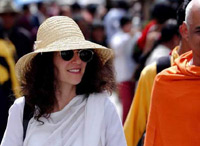
Overseas tourists have enjoyed unrestricted sightseeing in all the 70 counties of southwest China's Tibet Autonomous Region.
Altogether 1.34 million overseas sightseers have visited Tibet from 1980 to 2003, with 51,000 in last year alone, according to the official statistics.
"We welcome more foreigners to travel in Tibet, and no special forbidden zone would be imposed for them," said Wang, an official of the local tourism bureau.
Overseas tourists must have confirmation letters issued by Chinese governments before they enter Tibet, according to the regulation made by Chinese central government in 1989.
Currently, in Chinese metropolis including Beijing, Shanghai and Guangzhou, foreign tourists can easily secure a confirmation letter enabling them to travel freely in Tibet simply by presenting their passports. Chinese nationals also must obtained the letter, according to Wang.
"I've planned my Tibet trip for one year, but finished all the procedures in one day," Ben Long said at the square before the Potala Palace, an American enthusiast in Tibetan Buddhism. He works in northeast China's Liaoning Province as an English teacher.
In the prime tourism season from June to September, Tibet's capital city Lhasa receives thousands of overseas tourists each day. You can see them strolling in at Norbu-Linkag Park and the Potala Palace, a holy shrine for Tibetan Buddhists, shopping for Tibetan accessories, and hanging out in bars at night.
A couple named Chris and Eron from the United States, have just concluded their trip in famous Chinese scenic sites of Xi'an and Dunhuang before they flied to Lhasa.
"The travel agency did everything for us, so the application procedure is not that hard for us," said Chris.
Fluent in English, French, German and Japanese, more than 100 tourist guides in Tibet have helped tourists from all over the world to better understand the mysterious culture. From next year on, scores of new college graduates will join this guiding force each year, noted Wang.
Since Tibet is known as the holy land for Tibetan Buddhism, Wang also extended his welcome for devout worshipers from overseas. Nearly 600 Indian Buddhist worshippers flocked to Tibet each year to pay religious homage to the "Holy Mountain" and "Holy Lake" in its Ngari Prefecture.
Thonden, an official in charge of religious affairs in Tibet, said that now Tibetans worship many times more frequently than the period before 1958 due to enhanced living standard and communications conditions.
"Seeing is believing, so we'd like you to come to Tibet to have a look," Wang Pijun, an official with the Information Office of the State Council, usually tells foreigners.
Apart from the general foreign visitors, Tibet has also received many special guests in the recent years. This July, journalist delegations from several other countries including Belgium and Nepal have wrapped up their visits.
However, one thing that has bothered Ben Long and other travelers was the 5000 yuan (about US$602) return air ticket from Beijing to Lhasa, almost an equivalent of his one-month salary in China. Because of its high geographic altitude and comparatively inconvenient communications, expenses for a Tibet trip is higher than traveling in other areas in China.
But according to Wang Wenpei, transportation costs will be cut by two thirds after the completion of the 1,142 kilometer Qinghai-Tibet Railway, the highest railway line in the world which is expected to be open to traffic in 2007.
Please click here to see local weather.
Please click here for reservation.
Please click here to see more photos on Tibet.
(Xinhua News Agency July 23, 2004)
|

